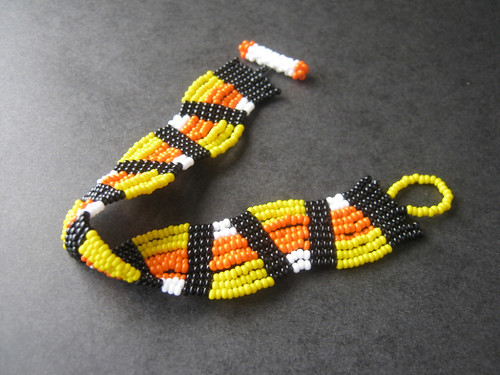
Wavy Wedges Square Stitch Bracelet
There are so many fun and interesting bead weaving techniques out there, that it takes a lot of time to try and master them all. Sometimes we see a technique that we like, but hesitate to experiment with it. Maybe it looks too difficult, or we think that it won’t suit our tastes, so we avoid using it and stick to the stitches that we really like.
This is how I felt about square stitch for a long time. I just didn’t see the point in learning another flat bead weaving stitch. Peyote was working just fine for me. Then I encountered a design dilemma, where I needed a grid-like stitch, and loom weaving was just too complex for my purpose. I pulled out an old square stitch tutorial and tried it out, only to discover that it is an amazing technique!
Square stitch is so delightfully simple, the steps can almost be explained in a single breath. And because the rows and columns are perfectly aligned, you can use ordinary
graph paper to create and plan unique patterns and designs. Square stitch can be worked with almost any type of seed bead, and looks fabulous with triangles and hex-cuts.
To weave a square stitch panel:

Attach a stop bead to a comfortable length of beading thread. If you’re working with beads larger than 11/o, it’s a good idea to leave an extra long tail, so you can add more reinforcements to the beadwork later.
Pick up any number of seed beads, odd or even. These will make up the base column. If you’re making a rectangular piece, like a bracelet, this will be the short side.

Turn the stop-bead away from you, and hold the new beads against it with your free hand. Pick up one bead, and stitch down into the last bead from the first column. Pull tight so that the new bead rests side-by-side with the other.

Stitch up into the new bead and pull the thread snug. Pick up a new bead, and stitch down into the next bead of the first column. Pull snug, and stitch up into the new bead.
Repeat this process up the column, and stitch up into the last bead added to exit from the edge of the beadwork. Flip the panel over and start again from the bottom, adding one new bead to each one from the last column.

If you’re working with a large quantity of beads in each row or column, or if you’re using bigger beads or Delicas, you will want to reinforce each column before adding a new one. To do this, stitch down through the previous column, then up through the one just added before you resume stitching.
Because square stitch is worked one bead at a time, it is lengthier stitch, like peyote. But because the technique is so easy, you’ll forget how much time each stitch takes and find yourself weaving up a storm.

For a quick introduction to the technique, try out the
Marching Cubes Bracelet by Marilyn Gardiner. You can also learn to do square stitch on the diagonal, using increases and decreases to make unique shapes. Start with a fun
Twisty Wrap Bracelet by Marji Brohammer. And for some extra visual aids, check out the three part video series from
Auntie’s Beads:
Square Stitch Bugle Bracelet.
Happy beading!
Copyright 2010
Inspirational Beading







Firstly, I would like to say that I find your blog and work to be incredibly inspirational. I am constantly seeking inspiration and often turn back to my routes. I grew up in Natal, South Africa where my love for beading began. The Candy Corn bracelet above reminds me a great deal of the Zulu beadwork in Southern Africa which has played an important role in the Zulu culture. They use colours and shapes to write letters to their loves. I find their work to be inspirational as they offer new meaning to everyday beading. Being able weave a story into each design creates uniqueness and value to that piece. Colours and the sequence in which they are used, play a critical role in writing these letters. According to Hilgard Schoeman, the colours in this bracelet would mean (I have substituted the orange for red as orange is not a colour they use in their writing):
ReplyDeleteBlack (with white next to it) - signifying marriage
Red {with black next to it) - signifying an aching heart; and
Yellow (following the negative black red combination) - signifying withering away/pining for
A basic Zulu interpretation of the Candy Corn bracelet could therefore be:
We are married but my heart is aching and pining for you because our love seems to be withering away.
Thanks for the great tutorial.
Candcie
http://beadmeup123.blogspot.com.au/
Thank you so much, Candice! I simply love Zulu beadwork, and the history and symbolism behind it. I'm so touched by your translation of this piece!
ReplyDelete